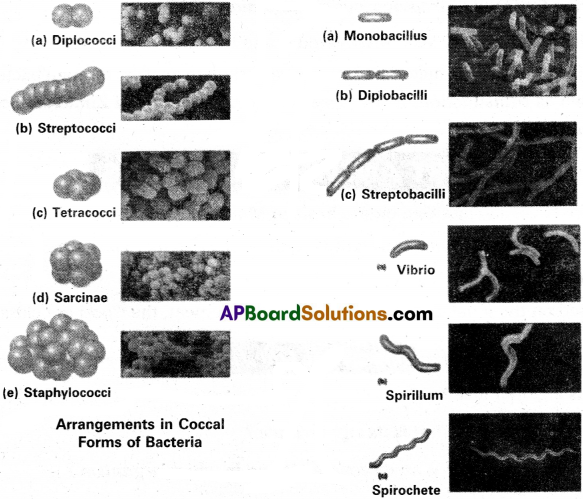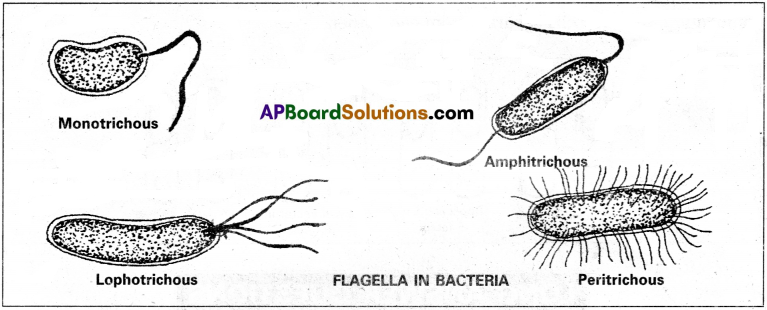Andhra Pradesh BIEAP AP Inter 2nd Year Botany Study Material 7th Lesson Bacteria Textbook Questions and Answers.
AP Inter 2nd Year Botany Study Material 7th Lesson Bacteria
Very Short Answer Questions
Question 1.
Write briefly on the occurrence of microorganisms.
Answer:
Microorganisms are omnipresent in vast numbers and are described as ubiquitous. Among them, Bacteria are found in soil, water, air and on or inside living organisms. They also occur in a variety of foods, can withstand extreme cold, heat and drought conditions.
Question 2.
Define Microbiology.
Answer:
Microbiology is a branch of biology that deals with the scientific study of microorganisms. That are too small to be seen with the naked eye.
Question 3.
Name the Bacteria which is a common inhabitant of human intestine. How is it used in biotechnology?
Answer:
Escherichia coli (E.coli). It is used in biotechnology for the production of Insulin hormone.
Question 4.
What are Pleomorphic Bacteria? Give an example.
Answer:
The Bacteria which change their shape depending up on the type of environment and nutrients available are called Pleomorphic Bacteria.
Eg : Acetobacter.
![]()
Question 5.
What is sex pilus? What is its function?
Answer:
Sex pilus is a conjugation apparatus that pulls two cells together prior to DNA transfer. It help in binding two conjugants and also help in passing F plasmid from F+ cell to F– cell.
Question 6.
What is a genophore?
Answer:
Genophore is the main genetic material of Bacteria which is circular, double stranded DNA without histone proteins. It is also called Bacterial chromosome.
Question 7.
What is a plasmid? What is its significance?
Answer:
“Plasmid is a small self-replicating circular, double stranded DNA molecule present in a Bacteria in addition to main genetic material”. They are used as agents (vectors) in modem Genetic Engineering techniques.
Question 8.
What is conjugation? Who discovered it and in which organism?
Answer:
Transfer of DNA from one Bacterium (Donor) to the recipient Bacterium through direct contact is called conjugation. It was first observed in Escherichia coli by Lederberg and Tatum (1946).
Question 9.
What is transformation? Who discovered it and in which organism?
Answer:
Uptake of naked DNA fragments from the surrounding environment and their incorporation into the recipient cell is called transformation. It was discovered by Frederick Griffith in Streptococcus pneumoniae (1928).
Question 10.
What is transduction? Who discovered it and in which organism?
Answer:
The transfer of genetic material from one bacterium to another through bacteriophage is known as transduction. It was observed by Lederberg and Zinder in Salmonella typhimurium (1951).
Short Answer Questions
Question 1.
How are bacteria classified on the basis of Morphology?
Answer:
Bacteria are classified into four types based on their shape. They are
I) Cocci : Spherical Bacteria.
Based on the number of cells and their arrangement, the Cocci are classified into
(a) Monococcus : A single cell
(b) Diplococcus : A pair of cells
(c) Tetracocci : A group of four cells
(d) Streptococcus : A linear chain of cells
(e) Staphylococci : A bunch of cells
(f) Sarcina : A group of 8 cells, arranged in cubes
II) Bacilli :
Rod-shaped Bacteria : The Bacillus forms exist as
a) Monobacillus : A single rod-shaped ceil.
b) Diplobacilli : A pair of rod-shaped cells.
c) Streptobacilli : A chain of rod-shaped cells.
III) Spirillum Helical rod-shaped cell.
It may be a distinct helical shape (spirillum) or Slender long and cork-screw shaped (Spirochete).
IV) Vibrio : Comma-shaped Bacteria.

Question 2.
How are Bacteria classified on the basis of number and distribution of flagella?
Answer:
Bacteria are classified into four types based on the number and arrangement of flagella.
They are
1) Monotrichous : A single polar flagellum is present at one end of Bacterial cell.
2) Lophotrichous : A tuft of flagella at one pole of the cell.
3) Amphitrichous : A single flagellum at each end of the cell.
4) Peritrichous : Flagella distributed over the entire cell.

Question 3.
What are the nutritional groups of Bacteria based on their source of .energy and carbon?
Answer:
1) Photoautotrophs :
They are photosynthetic i.e., they capture light energy and transform it into chemical energy and obtain carbon from atmospheric CO2.
Eg: Chlorobium, Chromatium,
2) Chemoautotrophs :
They derive energy from the oxidation of inorganic substances and carbon from atmospheric CO2.
Eg: Nitrosomonas, Nitrobacter, Beggiaotoaand Methanogens.
3) Photoheterotrophs :
They capture light energy and carbon from other organic sources.
Eg : Rhodospirillum and Rhodopseudomonas.
4) Chemoheterotrophs:
They derive both carbon and energy from organic compounds.
Eg: Xanthomonas, Salmonella.
![]()
Question 4.
Explain the conjugation in Bacteria.
Answer:
Transfer of Genetic material between two live Bacteria is called conjugation. It was first observed in 1946 by Lederberg and Tatum in Escherichia coli.
In E.coli, a small circular DNA strand occurs in the cytoplasm in addition to nucleoid called on F plasmid. The cell with F plasmid is called F+ cell and without F plasmid is called F– cell. The F+ cell or Donor cell produces the sex pilus that makes contact with the recipient cell or F– cell. During conjugation, F+ and F– cells bind with each other with the help of sex pilus forms a bridge between them. The F plasmid replicates and the replicated DNA passes through bridge to the F– cell. The F– cell becomes F+ cell as it receives the F plasmid. After conjugation, the two cells separate from each other.

Long Answer Questions
Question 1.
Explain different methods of sexual reproduction in Bacteria.
Answer:
True sexual reproduction is absent in Bacteria. However, the exchange of genetic material takes place in three ways. They are 1) Conjugation 2) Transformation 3) Transduction
1) Conjugation:-
Transfer of Genetic material between two live Bacteria is called conjugation. It was first observed in 1946 by Lederberg and Tatum in Escherichia coli.
In E.coli, a small circular DNA strand occurs in the cytoplasm in addition to nucleoid called on F plasmid. The cell with F plasmid is called F+ cell and without F plasmid is called F– cell. The F+ cell or Donor cell produces the sex pilus that makes contact with the recipient cell or F cell. During conjugation, F+ and F– cells bind with each other with the help of sex pilus forms a bridge between them. The F plasmid replicates and the replicated DNA passes through bridge to the F– cell. The F– cell becomes F+ cell as it receives the F plasmid. After conjugation, the two cells separate from each other.

2) Transformation:-
It is uptake of naked DNA fragments from the surrounding environment and their incorporation into the recipient chromosome in a heritable form is known as transformation. It was discovered by Frederick Griffith (1928) in Streptococcus pneumoniae.
3) Transduction:-
The transfer of genetic material from one Bacterium to another through Bacteriophage is known as transduction. It was discovered by Lederberg and Zinder in Salmonella typhimurium.
![]()
Question 2.
“Bacteria are friends and foes of man” – Discuss.
Answer:
Many Bacteria are directly or indirectly beneficial and harmful to humans. Hence they are considered both as friends and foes of man.
1) Beneficial activities:-
Some Bacteria are important to man in the field of agriculture, industry, medicine and biotechnology.
I) Agriculture :
Bacteria play a significant role in maintaining the fertility of the soil.
They are :
a) Ammonifying Bacteria:
These Bacteria convert the proteins, and amino acids of the dead bodies into Ammonia. This process is called Ammonification.
Eg: Bacillus
b) Ammonia is oxidised to nitrates, by nitrifying bacteria, This process is called Nitrification Eg: Nitrosomonas, Nitrobacter.
c) Symbiotic Bacteria like Rhizobium, non-symbiotic Bacteria like Clostridium and photosynthetic Bacteria like Rhodospirillum, Rhodomicrobium and Chlorobacterium fix the atmospheric gaseous nitrogen and enrich the soil.
d) Bacillus thuringiensis is used as an agent against insect pests. Hence popularly used as a bioinsecticide.
II) Industry:
Industrially, Bacteria are employed in a number of processes. They are :
a) Clostridium butyricum and C. felcinium are used in retting of sunhemp and flax respectively to extract the fibre.
b) Some Bacteria are used in tanning industry.
c) Bacteria such as Bacillus megaterium and Micrococcus are used in curing of tobacco and tea respectively.
d) Some Bacterm are used in fermentation process, Eg: Lactobacillus.
e) Bacteria like Methanococcus and Methanobacillus ferment the dung anaerobically and produce methane that is commonly referred to as gobar gas.
f) In various chemical industries, Bacteria are extensively used for the production of chemicals. Few, examples are given below.
| Chemical | Bacterium |
| Acetone, Butanol | Clostridium acetobutylicum |
| Vinegar | Acetobacter aceti |
| A. pasteurianum | |
| Lactic Acid | Lactobacillus delbruckii |
| Propionic Acid | Propionibacterium propionum |
| Ethanol | Zymomonas mobilis |
| Thermoanaerobacter ethanolicus |
III) Medicine:
a) Corynebacterium glutamicum produces lysine, an essential amino acid.
b) A large number of antibiotics are produced by Bacteria. Species of Streptomyces and Bacillus produce important antibiotics as mentioned below.
| Antibiotic | Bacterium |
| Streptomycin, Cyclohexamide | Streptomyces griseus |
| Chloramphenicol | S. venezuelae |
| Neomycin | S. fradiae |
| Kanamycin | S. kanamyceticus |
| Amphotericin | S. nodosus |
| Oxytetracycline | S. rimosus |
| Polymyxin B | Bacillus polymyxa |
| Bacitracin | B. licheniformis |
IV) Biotechnology:
a) With the help of recombinant DNA technology, it was made possible to produce insulin hormone from Escherichia coli.
b) Some Bacteria store large quantities of proteins inside their cells. These are used as a source of single cell protein (SCP).
Eg : Brevibatiterium.
c) Agrobacterium tumefaciens is used as vector in genetic engineering.
2) Harmful activities :
A few saprophytic and all parasitic Bacteria carry on some processes which are harmful to man.
i) Spoilage of food materials :
Bacteria grow on different types of food materials and render them unsuitable for human consumption. Some of these Bacteria produce powerful toxins while growing on the food materials. For instance, Clostridium botulinum releases a very potential toxin, ‘botulin’ which causes ’botulism’, a type of food poisoning.
ii) Plant diseases :
A number of species of Bacteria are reported to cause different plant diseases as mentioned below.
| Disease | Bacterium |
| Blight of rice | Xanthomonas oryzae |
| Citrus canker | X. axonopodis PV citri |
| Crown gall of apples and pear | Agrobacterium tumefaciens |
Some important crop diseases caused by Bacteria
Some Bacteria cause Human diseases. They are :
| Disease | Bacterium |
| Tetanus | Clostridium tetani |
| Botulism | Clostridium botulinum |
| Cholera | Vibrio cholera |
| Typhoid | Salmonella typhi |
| Diptheria | Corynebacterium diphtheriae |
| Tuberculosis | Mycobacterium tuberculosis |
| Leprosy | Mycobacterium leprae |
| Pneumonia | Diplococcus pneumoniae |
| Gonorrhoea | Neisseria gonorrhoea |
| Syphilis | Treponema pallidum |
Intext Questions
Question 1.
Many people believe that bacteria do little more than cause human illness and infectious diseases. How does the information in the chapter help you correct that misconception?
Answer:
Bacteria are directly or indirectly beneficial to Humans. Hence they are considered both as “friends and foes of man”.
![]()
Question 2.
An organism is described as a peritrichous bacillus. How might you translate this bacteriological language into a description of the organism.
Answer:
It is Rod shaped Bacteria.